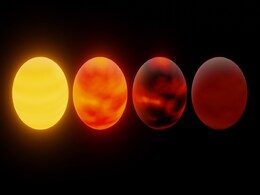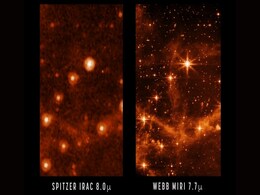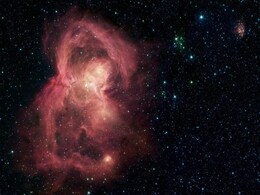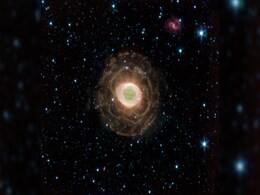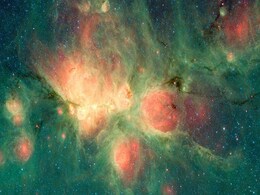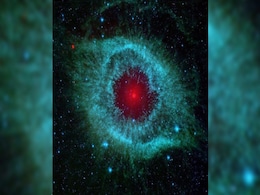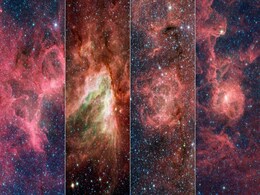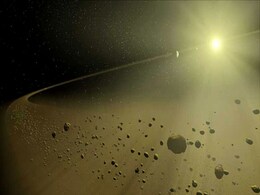Spitzer
- All
- News
- Videos
-

NASA's Spitzer Space Telescope Captures Extraordinary Image Of Milky Way's Heart
- Thursday January 5, 2023
- Feature |
The centre of our galaxy can be seen in the image on the middle-bottom right. With the darkness of space as its backdrop, interstellar dust and radiation come together to form a magnificent tapestry.
-
 www.ndtv.com
www.ndtv.com
-

Astronomers Discover Two Water Worlds 218 Light Years Away
- Saturday December 17, 2022
- World News |
Hubble and Spitzer Space Telescope data on a pair of exoplanets, Kepler-138 c and Kepler-138 d suggests that they may be water worlds.
-
 www.ndtv.com
www.ndtv.com
-

Scientists Find Out Why Some Distant Planets Have Clouds of Sands in Their Atmosphere
- Friday July 8, 2022
- Edited by Gadgets 360 Newsdesk
A new study has revealed the common trait that is conducive to sand cloud development on the planets. The study was led by researchers at the Western University who observed brown dwarfs. Brown dwarfs are celestial bodies having size larger than a planet but smaller than a star.
-
 www.gadgets360.com
www.gadgets360.com
-

NASA’s James Webb Space Telescope Captures Interstellar Image With Unprecedented Clarity
- Tuesday May 10, 2022
- Edited by Gadgets 360 Newsdesk
NASA's James Webb space telescope has delivered an image of a portion of the sky that was previously captured by the now retired Spitzer space telescope. The latest image is a lot sharper than the archival shot.
-
 www.gadgets360.com
www.gadgets360.com
-

'Space Butterfly': NASA Shares Image of 'Baby Stars' Cluster
- Friday April 15, 2022
- Edited by Gadgets 360 Newsdesk
NASA has shared an image of a cluster of baby stars, captured by its Spitzer Space Telescope. Calling the red clouds of gas a beautiful space butterfly, NASA says the image explains how stars are formed in space.
-
 www.gadgets360.com
www.gadgets360.com
-

Cosmic Flower in Bloom: NASA Shares Image of Ring Nebula
- Tuesday March 22, 2022
- Edited by Gadgets 360 Newsdesk
NASA has shared a stunning image of a “cosmic flower in bloom” on Instagram. The photograph showed a heavenly entity resembling a flower in the Ring Nebula, which is located about 2,000 light-years away from us, in the constellation Lyra.
-
 www.gadgets360.com
www.gadgets360.com
-

NASA Shows Giant Debris Cloud Formed by Collision of Celestial Bodies
- Monday March 21, 2022
- Edited by Gadgets 360 Newsdesk
Most rocky planets and satellites, including our Earth and the Moon, are formed or shaped by massive collisions among celestial bodies early in the solar system. When these objects smash together, they could either accumulate more material and increase their size or they can break apart into multiple smaller bodies.
-
 www.gadgets360.com
www.gadgets360.com
-

NASA’s Spitzer Telescope Captures Image Of The Cat's Paw Nebula
- Monday November 8, 2021
- Edited by Gadgets 360 Newsdesk
American space agency NASA has shared an image of Cat’s Paw Nebula, which is named so for the "large, round features that resemble a feline footprint".
-
 www.gadgets360.com
www.gadgets360.com
-

NASA Shares Image of Helix Nebula, a Giant Eye in Sky
- Tuesday November 2, 2021
- Edited by Gadgets 360 Newsdesk
NASA has shared a stunning image of a giant eye-shaped nebula that is among the brightest and closest to Earth. The image, captured by the agency's Spitzer Space Telescope, showed a deep vacuum surrounded by a sparkling cloud of dust and gas.
-
 www.gadgets360.com
www.gadgets360.com
-

NASA Explains Why 'Stars Are Just Like Us' With Stunning Pictures of Four Nebulae
- Wednesday September 15, 2021
- Edited by Gadgets 360 Newsdesk
NASA often shares images of the Earth and space that leaves social media users in awe. This time around, the space agency shared not one but four images of nebulae — star-forming gaseous clouds — on its official Instagram page.
-
 www.gadgets360.com
www.gadgets360.com
-

NASA Shares Captivating Picture of a Supernova Remnant, Calls It 'A Kaleidoscope of Colour'
- Monday August 2, 2021
- Edited by Gadgets 360 Newsdesk
NASA has shared a beautiful image of Cas A, the remnant of a massive star that exploded about 300 years ago, on its Instagram. The picture justifies the title picked by the space agency, which called it 'A Kaleidoscope of Colour'.
-
 www.gadgets360.com
www.gadgets360.com
-

Scientists Discover a New Planet Hidden in a Debris Disk of a Young Star
- Thursday June 25, 2020
- Abhik Sengupta
Astronomers have a found a new exoplanet hiding in the debris disk of a star. Dubbed as AU Mic b, the exoplanet was found after decades of search, around the red dwarf star, AU Microscopii that is roughly 32 light-years away.
-
 www.gadgets360.com
www.gadgets360.com
-

NASA Bids Farewell to Spitzer Telescope After 16 Years of Service
- Friday January 31, 2020
- Indo-Asian News Service
NASA has said goodbye to the Spitzer space telescope after 16 years of service using infrared light to unveil otherwise invisible features of the universe, including seven planets the size of Earth around the star Trappist-1.
-
 www.gadgets360.com
www.gadgets360.com
-

Space Telescope Offers Rare Glimpse Of Earth-Sized Rocky Exoplanet
- Tuesday August 20, 2019
- Science | Reuters
Direct observations from a NASA space telescope have for the first time revealed the atmospheric void of a rocky, Earth-sized world beyond our own solar system orbiting the most common type of star in the galaxy, according to a study released on Monday.
-
 www.ndtv.com
www.ndtv.com
-

NASA's Spitzer Space Telescope to Retire in 2020
- Friday June 14, 2019
- Indo-Asian News Service
NASA's Spitzer Space Telescope will be switched off permanently on January 30, 2020, after nearly 16 years of exploring the cosmos in infrared light.
-
 www.gadgets360.com
www.gadgets360.com
-

NASA's Spitzer Space Telescope Captures Extraordinary Image Of Milky Way's Heart
- Thursday January 5, 2023
- Feature |
The centre of our galaxy can be seen in the image on the middle-bottom right. With the darkness of space as its backdrop, interstellar dust and radiation come together to form a magnificent tapestry.
-
 www.ndtv.com
www.ndtv.com
-

Astronomers Discover Two Water Worlds 218 Light Years Away
- Saturday December 17, 2022
- World News |
Hubble and Spitzer Space Telescope data on a pair of exoplanets, Kepler-138 c and Kepler-138 d suggests that they may be water worlds.
-
 www.ndtv.com
www.ndtv.com
-

Scientists Find Out Why Some Distant Planets Have Clouds of Sands in Their Atmosphere
- Friday July 8, 2022
- Edited by Gadgets 360 Newsdesk
A new study has revealed the common trait that is conducive to sand cloud development on the planets. The study was led by researchers at the Western University who observed brown dwarfs. Brown dwarfs are celestial bodies having size larger than a planet but smaller than a star.
-
 www.gadgets360.com
www.gadgets360.com
-

NASA’s James Webb Space Telescope Captures Interstellar Image With Unprecedented Clarity
- Tuesday May 10, 2022
- Edited by Gadgets 360 Newsdesk
NASA's James Webb space telescope has delivered an image of a portion of the sky that was previously captured by the now retired Spitzer space telescope. The latest image is a lot sharper than the archival shot.
-
 www.gadgets360.com
www.gadgets360.com
-

'Space Butterfly': NASA Shares Image of 'Baby Stars' Cluster
- Friday April 15, 2022
- Edited by Gadgets 360 Newsdesk
NASA has shared an image of a cluster of baby stars, captured by its Spitzer Space Telescope. Calling the red clouds of gas a beautiful space butterfly, NASA says the image explains how stars are formed in space.
-
 www.gadgets360.com
www.gadgets360.com
-

Cosmic Flower in Bloom: NASA Shares Image of Ring Nebula
- Tuesday March 22, 2022
- Edited by Gadgets 360 Newsdesk
NASA has shared a stunning image of a “cosmic flower in bloom” on Instagram. The photograph showed a heavenly entity resembling a flower in the Ring Nebula, which is located about 2,000 light-years away from us, in the constellation Lyra.
-
 www.gadgets360.com
www.gadgets360.com
-

NASA Shows Giant Debris Cloud Formed by Collision of Celestial Bodies
- Monday March 21, 2022
- Edited by Gadgets 360 Newsdesk
Most rocky planets and satellites, including our Earth and the Moon, are formed or shaped by massive collisions among celestial bodies early in the solar system. When these objects smash together, they could either accumulate more material and increase their size or they can break apart into multiple smaller bodies.
-
 www.gadgets360.com
www.gadgets360.com
-

NASA’s Spitzer Telescope Captures Image Of The Cat's Paw Nebula
- Monday November 8, 2021
- Edited by Gadgets 360 Newsdesk
American space agency NASA has shared an image of Cat’s Paw Nebula, which is named so for the "large, round features that resemble a feline footprint".
-
 www.gadgets360.com
www.gadgets360.com
-

NASA Shares Image of Helix Nebula, a Giant Eye in Sky
- Tuesday November 2, 2021
- Edited by Gadgets 360 Newsdesk
NASA has shared a stunning image of a giant eye-shaped nebula that is among the brightest and closest to Earth. The image, captured by the agency's Spitzer Space Telescope, showed a deep vacuum surrounded by a sparkling cloud of dust and gas.
-
 www.gadgets360.com
www.gadgets360.com
-

NASA Explains Why 'Stars Are Just Like Us' With Stunning Pictures of Four Nebulae
- Wednesday September 15, 2021
- Edited by Gadgets 360 Newsdesk
NASA often shares images of the Earth and space that leaves social media users in awe. This time around, the space agency shared not one but four images of nebulae — star-forming gaseous clouds — on its official Instagram page.
-
 www.gadgets360.com
www.gadgets360.com
-

NASA Shares Captivating Picture of a Supernova Remnant, Calls It 'A Kaleidoscope of Colour'
- Monday August 2, 2021
- Edited by Gadgets 360 Newsdesk
NASA has shared a beautiful image of Cas A, the remnant of a massive star that exploded about 300 years ago, on its Instagram. The picture justifies the title picked by the space agency, which called it 'A Kaleidoscope of Colour'.
-
 www.gadgets360.com
www.gadgets360.com
-

Scientists Discover a New Planet Hidden in a Debris Disk of a Young Star
- Thursday June 25, 2020
- Abhik Sengupta
Astronomers have a found a new exoplanet hiding in the debris disk of a star. Dubbed as AU Mic b, the exoplanet was found after decades of search, around the red dwarf star, AU Microscopii that is roughly 32 light-years away.
-
 www.gadgets360.com
www.gadgets360.com
-

NASA Bids Farewell to Spitzer Telescope After 16 Years of Service
- Friday January 31, 2020
- Indo-Asian News Service
NASA has said goodbye to the Spitzer space telescope after 16 years of service using infrared light to unveil otherwise invisible features of the universe, including seven planets the size of Earth around the star Trappist-1.
-
 www.gadgets360.com
www.gadgets360.com
-

Space Telescope Offers Rare Glimpse Of Earth-Sized Rocky Exoplanet
- Tuesday August 20, 2019
- Science | Reuters
Direct observations from a NASA space telescope have for the first time revealed the atmospheric void of a rocky, Earth-sized world beyond our own solar system orbiting the most common type of star in the galaxy, according to a study released on Monday.
-
 www.ndtv.com
www.ndtv.com
-

NASA's Spitzer Space Telescope to Retire in 2020
- Friday June 14, 2019
- Indo-Asian News Service
NASA's Spitzer Space Telescope will be switched off permanently on January 30, 2020, after nearly 16 years of exploring the cosmos in infrared light.
-
 www.gadgets360.com
www.gadgets360.com



